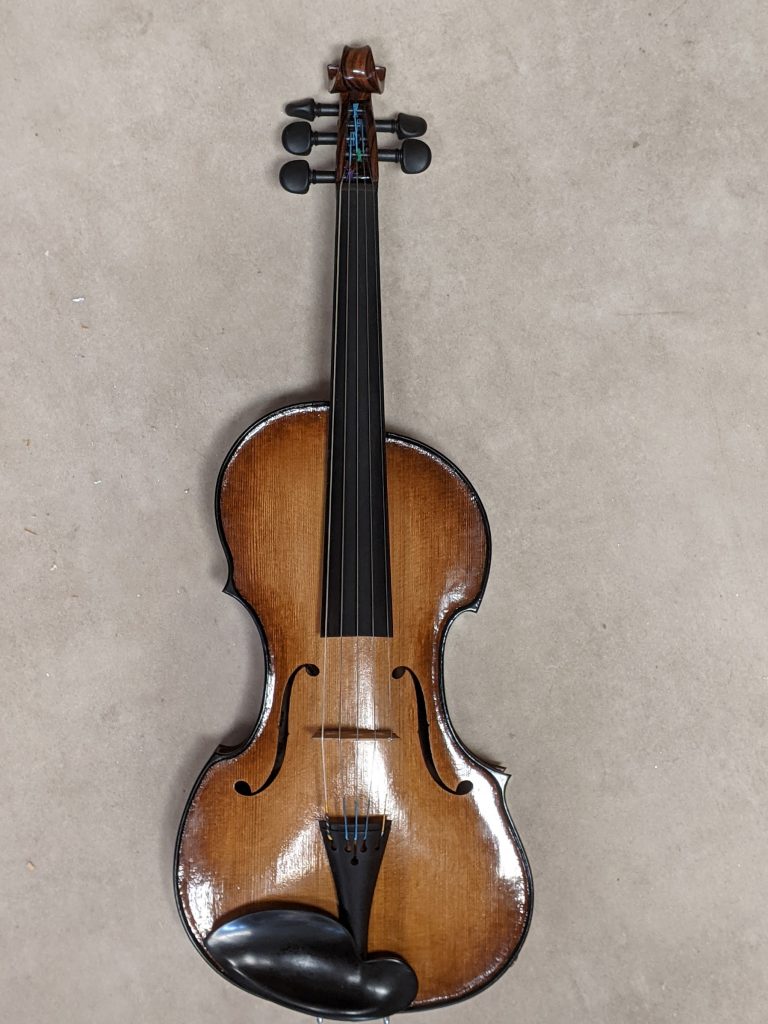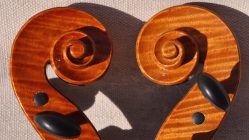
The five-string violin, or quinton, is gaining popularity. It offers violinists seeking lower tones, or violists seeking higher ones, the opportunity to combine the range (and to a lesser extent the tessiture) of two instruments into one.
The quinton has been around since the late 18th century, where it experienced a brief period of glory, particularly in France and Germany, much like its counterpart, the violoncello piccolo.
If the violin family has returned to a reduced number of strings compared to the viola da gamba family, it’s because fewer strings, more tightly strung, produce a richer sound in harmonics, and above all, more powerful. Thus, the fifth string on an acoustic violin tuned to C, G, D, A, E, tends to “consume” some of the sound – which probably explains the relatively rapid abandonment of the historical quinton by classical violinists. It should also be noted that apart from original compositions, there was not much interest in having it, as the sound spectrum down to the low strings was already well covered by the four representatives of the violin family – double bass, cello, viola, and violin.

This changed in the twentieth century with the adoption of the violin and the introduction of the electric violin in musical styles such as jazz, rock, then metal, electro, etc., where there is rarely the opportunity to integrate the entire range into a group, but where one still does not want to deprive oneself of the violin’s particular sound color in lower registers.
Familiar with the five-string violin for about twenty years, I believe it’s a bad idea to just add a fifth C violon string to a violin (which will have a flat and raspy sound), or a fifth E string to a viola (which will be too tight and strident). The modern quinton should be treated as a separate instrument. Therefore, a bit of extra body volume should be given while keeping a standard length string vibration for more playing comfort and to avoid losing reference points. This can easily be achieved by increasing the height of the ribs, and especially by designing an asymmetrical shape, enlarged on the side of the lower strings, which also greatly contributes to a rich tone and sound balance. Indeed, the violin is asymmetric by default, with its soundpost on one side and the bass bar on the other. This is not visible from the outside because in the baroque period from which the violin originates, asymmetry was heresy – today, we have the right to it!

Similarly, a bit more leverage should be given to the bass bar by placing it further towards the outside, which is achieved by enlarging the “chest”, that is raising the f-hole distance, which also allows for a slightly wider bridge, which in turn makes it possible to maintain a fairly standard string spacing between C, G, D, A, E strings. Tailpieces with five integrated fine tuners or high quality geared pegs make tuning less of a hassle.
Finally, arching that provide more bass can be favored – a rather flat and taut arching for a direct “viola” sound, or, my preference, a “tunnel” type arching with a rounded crest, which also provides more complex harmonics. At the other end of the violin, more modifications are necessary – the fingerboard should be slightly wider at the top nut to allow for a sufficiently large string spacing while avoiding getting too close to the edges of the fingerboard with the outer strings.
Thus, I have created quintons based on large old violins (with a length of 36 cm and above, high ribs, wide f-hole spacing) that work really well. For quintons based on the Neolin electro-acoustic violin, I resort to an additional trick: Inspired by guitar construction, its top is thinner outside the central stress zone, reinforced by small diagonal bars. This “pulls” the sound more towards the lower sounds, or rather the fundamentals, with very equal harmonics that come out well when amplified.
Which brings us to the last point, amplification: Very complex and high harmonics are not the strength of pickups, especially piezo cystals, or amps. This is just fine for us – the relatively low frequency of the C-string is perfectly suited to the large bass membrane of most amps. Thus, even a shorter and less tense C string than on a viola develops a nice, round, and fat sound when coming out of the amp. Lucky coincidence : many modern quintons are meant to be played in an amplified environment, rather than traditional acoustic instrument.
As a result, the Electrolin electric violin in a five-string version immediately emerged as an obvious addition to the Elctrolin range !
I offer 5 string violins starting from 1260 Euros based on a small 36 cm Chinese-made viola. Expect to pay between 2500 and 6000 for a converted antique (depending on its “pedigree” and the condition of the original violin), and starting from 3126 Euros for a Quinton made by me based on the Neolin model. As for the Electrolin in its 5-string version, you can become the proud owner starting from 2500 Euros.








